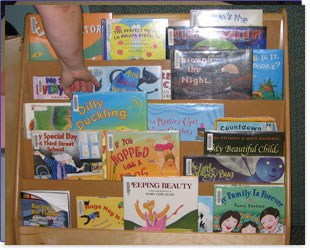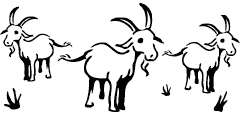  (Page 6 of 7) (Page 6 of 7)
Be very careful not to turn your reading sessions
into question-and-answer sessions where only the
teacher asks the questions and children raise
their hands to answer the questions. Children
should ask and answer as many questions as the
teacher does, maybe even more! Keep in mind that
children with limited language skills will need
you to ask simple questions in the beginning.
Questions like these will help them acquire some
basic vocabulary, like the names of common objects
and actions. A good way to do this is to ask simple
who, what, when, where and why (WH) questions about the illustrations, like “What
is this?” “Where are they?”
“Who is this?” Remember, good readers
are active thinkers, not passive listeners!
 You will need to prepare ahead of
time for interactive reading. What kind of books
should you select for interactive reading? High-quality
books, of course. Books that are high quality
for interactive reading have clear and recognizable
pictures. The illustrations are full-page, full-color,
eye-catching and realistic rather than imaginary.
The pictures vary within and across different
pages. Books with single images in isolation do
not work well for interactive reading. During
interactive reading the pictures are used to help
build content knowledge and understanding of word
meanings and concepts, so the quality of the illustrations
is very important. Try to use both story and informational
books for interactive reading. Look for books
with about two to six sentences for every two
pages. Try to avoid books with labels only, or
books with more text than illustration. Most of
all, choose books that are interesting and fun
for the children. You will need to prepare ahead of
time for interactive reading. What kind of books
should you select for interactive reading? High-quality
books, of course. Books that are high quality
for interactive reading have clear and recognizable
pictures. The illustrations are full-page, full-color,
eye-catching and realistic rather than imaginary.
The pictures vary within and across different
pages. Books with single images in isolation do
not work well for interactive reading. During
interactive reading the pictures are used to help
build content knowledge and understanding of word
meanings and concepts, so the quality of the illustrations
is very important. Try to use both story and informational
books for interactive reading. Look for books
with about two to six sentences for every two
pages. Try to avoid books with labels only, or
books with more text than illustration. Most of
all, choose books that are interesting and fun
for the children.
Read the story to yourself and pick four or five places to stop and ask one or two questions, make a comment, or ask for a prediction about what will happen next. Try to ask questions that require students to think and reason about what is happening in the story.
 For example, when reading The Three Billy Goats Gruff you might ask your students, “Why is the troll willing to wait for the second billy goat?” For example, when reading The Three Billy Goats Gruff you might ask your students, “Why is the troll willing to wait for the second billy goat?”
Keep in mind that as you encourage children
to actively participate in conversations about
the book, they might take you in an unexpected
direction. They might see and understand what
is happening in the book in a different way
from what you saw and understood. Be
willing to follow their lead. Encourage
them to back up their statements with details
in the illustrations or with their own experiences.
|